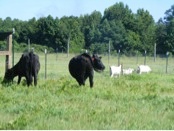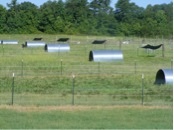Ever thought about the greatest threats to goats and sheep in the southern United States? Well I’ll tell you, it’s definitely not a wolf in sheep’s clothing.
t individual . To leAt Tuskegee, CAENS Assistant Professor of Animal Science, Dr. Min Byeng-Ryel thinks about the real threats every day in his research work. Ask Dr. Byeng-Ryel and he will tell you that gastrointestinal parasites (GI) (especially Haemonchuscontortus and Eimeria spp.) present the greatest danger to the South’s goat and sheep industry. Infected animals have lower growth rates, reduced reproductive performance, and higher rates of illness and death. In the past, sheep and goat producers have relied heavily on anti-parasitic drugs to deal with this problem, but over time the parasites have become increasingly resistant to these drugs.
Dr. Byeng-Ryel is working to address this problem by identifying sustainable and affordable alternative methods of GI parasite control. Previous research had shown that legumes such as Sericea lespedeza (Lespedeza cuneata) contain condensed tannin (CT) with anti-parasitic properties that reduced GI parasitic infection in goats in Oklahoma and Georgia and in sheep in Louisiana. . [Insert a sentence or two about the grad students who help with the research and how long they’ve been working. These are details that are of interest to prospects.]
At Tuskegee, Dr. Byeng-Ryel and his team have found that pine bark has tremendous potential for parasite control. Pine bark is an abundant forest byproduct in the southern United States and contains 11-to-13 percent CT on a dry matter basis. They found that goats fed on a pine bark diet had up to 30 percent fewer worms in a total ration, as well as lower instances of fecal egg count and fecal coccidian oocyst count. (Coccidia are another type of parasite.)
Other benefits also were observed for the goats on the pine bark diet. They showed greater mean dry matter intake, feed efficiency, average daily gain, and cold carcass weight. On-farm research with local farmers in Alabama also has shown that goats on a pine bark diet had 74 percent lower fecal egg counts and five percent better animal weight gain compared to control diets during three-month trials.
What this all means is that ground pine bark as a feed ingredient has the potential to improve animal performance while decreasing internal parasites and coccidian infection.
“Pine bark and other plant based alternatives show great promise as an affordable and sustainable method to control GI parasites in goats and sheep,” said Dr. Byeng-Ryel. “More research is needed to study the direct mechanisms of tannins and parasite interactions and to look for ways of validating the anti-parasitic plants of sheep and goat production systems. We also need to continue testing the effectiveness of alternative natural dewormers for use in ruminants.”
This CAENS research enables goat production to be a more sustainable and low-cost enterprise. Mitigating the threats of GI parasites leads to enhancing overall meat production, protecting animal and human health, increasing producer profits, and providing a stable and safe food supply.
To explore details about research, read this report published by the American Consortium for Small Ruminant Parasite Control (ACSRPC)
Caprine Connection - Tuskegee University historically has a significant contribution in the area of goat research and the Caprine Connection builds capacity to extend our research activities to the community.


Figure 1. Co-grazing of cow-goats, Caprine Research and Education Unit,
Tuskegee University, AL
arn more abot internships, contact CAENS at

